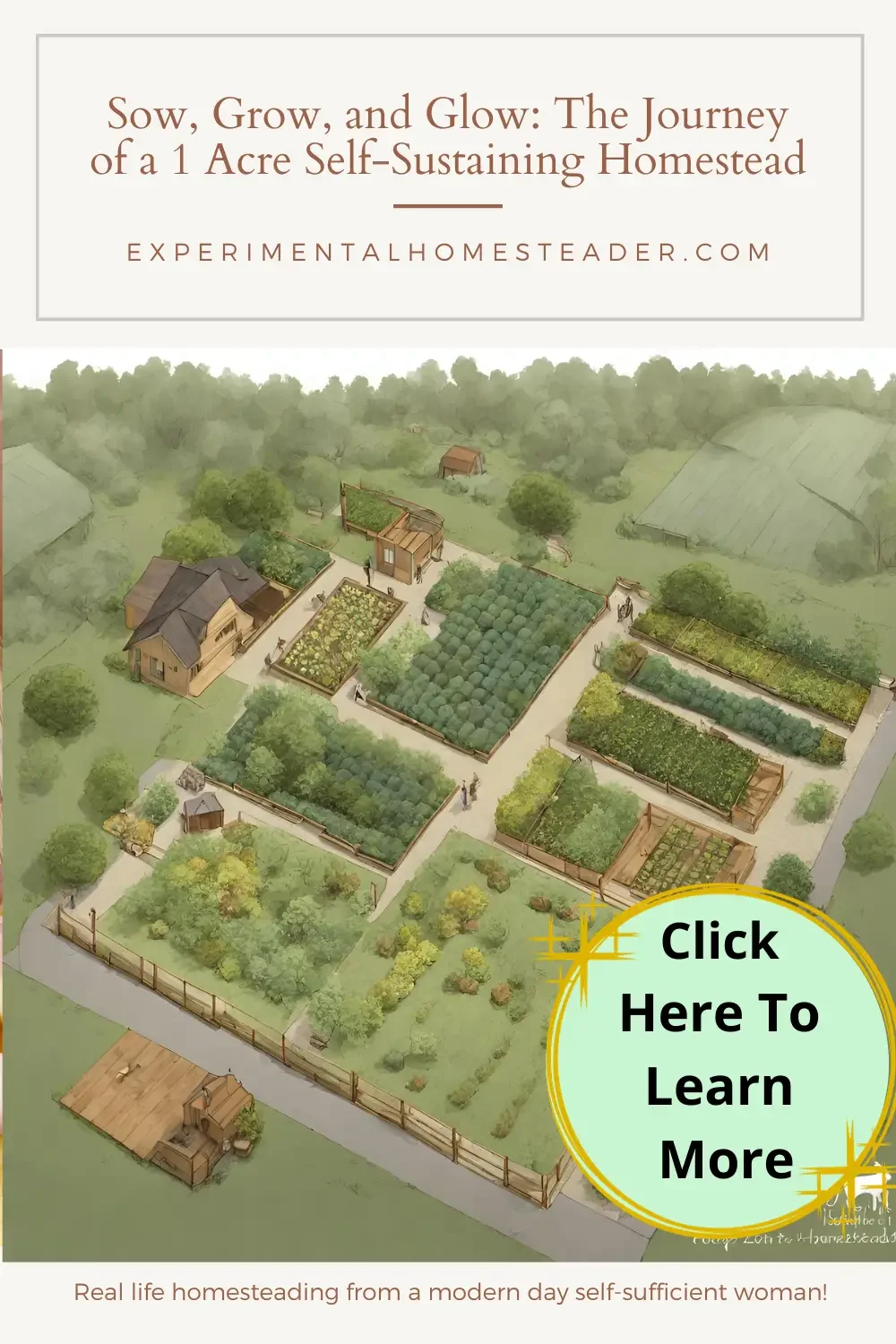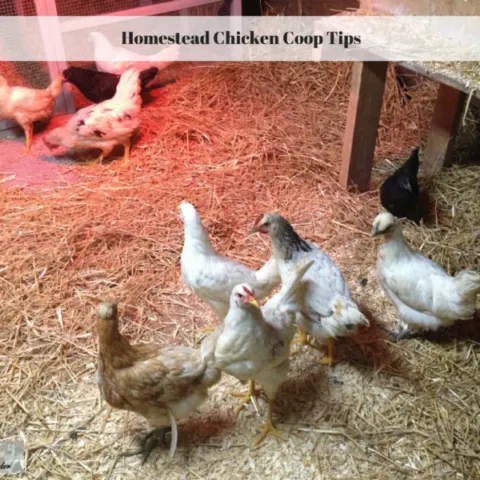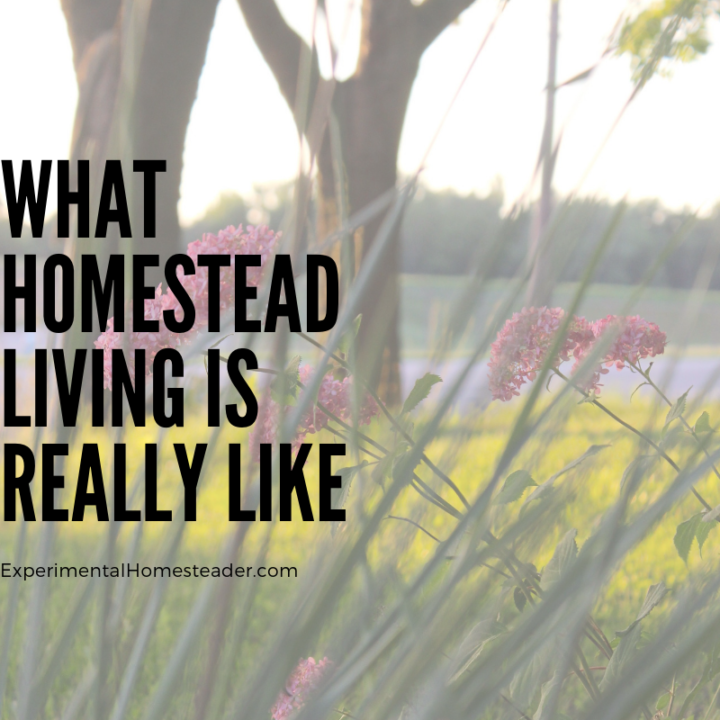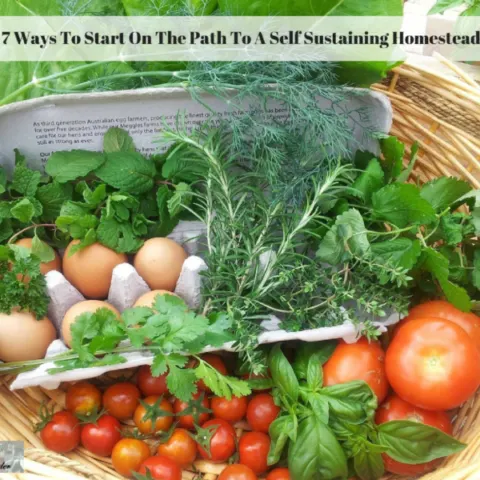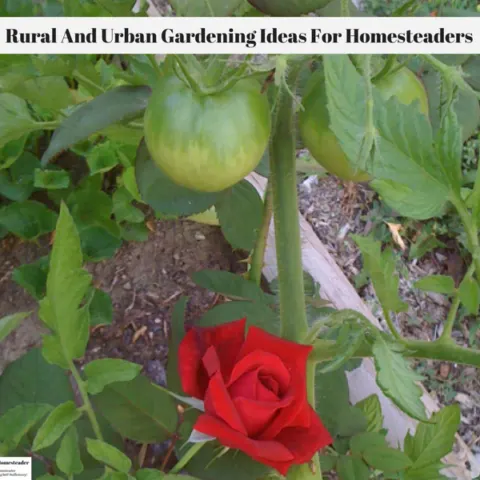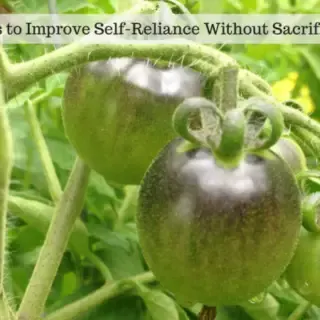Embracing the principles of sustainability, self-reliance, and ecological harmony, I find myself on the path of a 1 acre self sustaining homestead.
Here on my own 1.5-acre homestead, I use roughly 1 acre for various homesteading activities, and it’s been an incredible journey.
Reflecting on the past, the idea of a self-sustaining homestead is far from new.
It harks back to a time when individuals and families lived off the fruits of their labor on small tracts of land, much like I do now.
This blend of tradition and modern sustainable practices opens up an exciting opportunity.
We can create a thriving, productive ecosystem within just 1 acre – or thereabouts, as I do on my 1.5-acre plot.
From the initial stages of planning and designing your homestead to the hands-on aspects of growing your own food, raising livestock, crafting energy-efficient homes, and mastering the art of preserving and storing your produce – this comprehensive guide ensures you become well-versed in all these imperative elements of homesteading.
So, join me as we explore the incredible world of a 1 acre self-sustaining homestead, where sustainability, self-reliance, and ecological harmony converge to create a harmonious and abundant way of life.
Planning and Zoning for a 1-Acre Homestead
When it comes to homesteading on a small piece of land, meticulous planning and zoning are vital.
On just 1 acre, you can create a fully functional, sustainable homestead that produces bountiful yields for years to come.
The key is to divide your acre into four essential zones:
- Residential Zone: Allocate approximately a quarter of your acre for your house and any maintenance or utility buildings.
- Livestock Zone: Depending on your climate and region, dedicate space for livestock such as chickens, rabbits, goats, and bees.
- Garden Zone: Create a space for your garden beds, and maximize vegetable production with techniques like raised beds, vertical planting, and square foot gardening.
- Orchard Zone: If suitable for your area, establish an orchard with fruit trees for a steady yield of delicious fruits over many years.
Designing a Sustainable Garden And Orchard
The next step involves creating a sustainable garden.
Raised garden beds, vertical planting, and square foot gardening are techniques that can maximize vegetable production, even in limited spaces.
Plant vegetables that produce high yields like tomatoes, peppers, beans, and zucchini.
On the other hand, permaculture techniques, a sustainable way of organizing a diverse ecosystem, might be employed for sustainable design of your garden landscape.
Depending on the climate and region where the homestead is located, having a dedicated orchard for fruit trees can provide an abundant yield of fruits over many years.
The rest of the acreage can be allocated as per needs and preference between gardening beds and livestock.
Choosing the Right Livestock
Choosing the right livestock is critical as not all animals are suitable for a small-scale homestead.
Chickens, goats, and bees occupy less space compared to cows or horses, and can still provide plentiful meat, dairy, and honey.
Integrating Livestock and Garden
Creating a symbiotic relationship between your garden and livestock is a key element of a successful 1-acre homestead.
One innovative approach to achieving this harmony is through the use of chicken tractors – portable chicken coops designed to bring both productivity and sustainability to your homestead.
Chicken Tractors: Your Garden’s Best Friend
Chicken tractors are a remarkable concept where chickens play a dual role as both feathered friends and diligent gardeners.
These mobile coops are placed strategically in your garden beds.
As chickens move about, they not only enjoy the freedom to forage and peck at insects but also contribute significantly to your garden’s health.
Tilling and Fertilizing
One of the primary advantages of chicken tractors is their ability to till the soil.
Chickens are natural diggers, and their constant scratching and pecking help to aerate the soil, keeping it loose and fertile.
This natural tilling process reduces the need for manual labor and tilling machinery, making your gardening endeavors more efficient.
Moreover, as chickens go about their daily business, they leave behind nutrient-rich droppings.
These droppings act as a potent organic fertilizer, enriching the soil with valuable nutrients.
This not only promotes healthier plant growth but also reduces the reliance on synthetic fertilizers, aligning perfectly with sustainable practices.
A Closed-Cycle System
The beauty of integrating chicken tractors into your garden is the creation of a closed-cycle system with minimal waste.
In this harmonious ecosystem, garden scraps and surplus crops become chicken feed, while the chickens, in turn, contribute to the garden’s vitality.
This closed-loop not only reduces waste but also enhances the overall sustainability of your homestead.
In essence, the marriage of chicken tractors and your garden creates a mutually beneficial relationship that boosts productivity and sustainability.
As your chickens happily scratch, peck, and fertilize, they play an essential role in nurturing your garden, and your garden, in return, provides nourishment for your flock.
It’s a partnership that exemplifies the principles of self-sustaining living and the beauty of interconnected systems on your 1-acre homestead.
Efficient Water Systems
Incorporating an efficient water system is also paramount.
Rainwater collection systems, drip irrigation, and greywater recovery can help to conserve water while ensuring all plants and animals on your homestead have their daily needs met.
Energy Sustainability
Lastly, don’t forget about energy sustainability.
Solar panels and wind turbines could provide renewable energy and contribute to a self-sufficient homestead.
Furthermore, using energy-efficient appliances, lighting, and passive solar designs help reduce the overall energy requirements.
Achieving Sustainability on 1 Acre
In conclusion, crafting a productive and sustainable homestead on 1 acre of land may seem challenging, yet with the right planning and design, it’s achievable.
This section summarizes the key points, emphasizing that with proper zoning, maximizing garden production, wise livestock choices, and efficient water and energy systems, you can create a thriving homestead on just 1 acre.
It’s a journey filled with ongoing learning and the joy of self-sufficiency.
Growing Your Own Food
One of the most enchanting aspects of homesteading is the remarkable ability to transform a single acre of land into a bountiful source of nourishment.
Picture your modest piece of earth providing fruits, vegetables, eggs, honey, and even meat for your family.
The best part?
It’s entirely achievable with some clever strategies and a touch of hard work.
Let’s explore the art of maximizing food production on your small homestead, moving beyond zoning, water systems, and livestock choices.
The Alchemy of Composting
Delving into the details, even beginner homesteaders understand that plants require nourishment.
Enter composting, often referred to as “black gold for gardeners.”
Compost lies at the heart of a thriving garden, enhancing soil structure, retaining moisture, and gradually feeding your plants.
It’s the true essence of recycling – transforming kitchen scraps, garden cuttings, and even chicken waste into black gold for your garden.
Chickens: A Source of Green Energy
Speaking of chickens and their manure, they offer more than just eggs.
Methane Digestion is a technique that converts chicken droppings into fuel for cooking and heating.
It’s a brilliant way to minimize waste and maximize utility on your homestead.
Stacking Functions for Efficiency
Next, we embrace the key homesteading principle of “stacking functions.”
It means that every element of your acreage should serve multiple purposes, increasing its utility and efficiency.
For instance, planting fruit or nut trees on the edge of your plot can act as both a privacy fence and a source of food.
Trellises and pergolas provide shade for sun-sensitive plants and serve as climbing structures for beans, gourds, and grapes.
Welcome the Bees
Consider introducing an apiary, even a small one if your area permits.
Bees are vital for successful pollination of your fruits and vegetables, increasing production.
Plus, they sweeten the deal with delicious honey.
Intercropping and Companion Planting
No discussion on maximizing food production is complete without mentioning intercropping and companion planting.
This practice involves growing different crop types in close proximity, encouraging biodiversity and efficient space utilization.
For instance, marigolds repel aphids and attract pollinators, making them ideal companions for various plants in your garden.
Extend the Growing Season
Installing a mini greenhouse or tunnel can significantly extend your growing season.
This allows you to cultivate cool-weather crops like lettuce, kale, and spinach in early spring and late fall, and it provides protection for warm-weather crops during unpredictable weather conditions.
Consider a Pond or Aquaponics
Don’t underestimate the potential of a pond or an aquaponics system.
These systems may seem complex initially but promise fresh fish and natural irrigation for your plants, making them worthwhile ventures.
Cultivating Abundance on Your 1-Acre Homestead
Incorporating all these elements into your homesteading practice will truly make a difference.
Remember, it’s not always about having acres of land; it’s about using what you have to the fullest.
With a well-thought-out plan, a dash of creativity, and a pinch of patience, a 1-acre homestead can transform into a thriving food-producing oasis.
So, put on those gardening gloves, and let the magic of abundance begin.
Choosing The Right Livestock
Homesteading on a single acre requires careful planning, especially when it comes to selecting the right livestock.
The choice of animals can significantly impact the balance and sustainability of your compact homestead.
Poultry: The Compact All-Stars
Many homesteaders turn to poultry as the backbone of their one-acre farm due to their manageable size and versatile benefits.
Chickens, for instance, offer farm-fresh eggs, help control garden pests like ticks and slugs, and provide valuable manure for compost.
If space allows, a rooster can support self-sustainability through egg hatching.
Generally, around 10 chickens can comfortably reside in a well-proportioned coop.
Goats: Small But Mighty
Goats are another favorite for their surprising milk production, which can be used for cheese and butter.
They also assist in managing vegetation within designated areas, helping maintain the homestead’s landscape.
Typically, having at least two but no more than four goats strikes a balance on a one-acre homestead.
Pigs: The Game-Changers
For those with a taste for pork, introducing a couple of pigs can be transformative.
These omnivorous animals not only provide meat but also serve as barnyard recyclers by consuming kitchen scraps and converting them into valuable compost.
Managing Your Livestock
Once you’ve selected your livestock, proper management is crucial.
Ensuring adequate space for foraging and shelter from the elements is essential.
Fencing plays a pivotal role in safeguarding both the garden and livestock from straying out of designated areas.
Feeding and Forage Systems
Feeding livestock goes beyond sustenance; it’s about creating a symbiotic relationship between animals and the land.
Implement a forage system where plants grown for animal feed provide ground cover and soil-building capabilities.
The livestock’s grazing and manure production nourish the soil and feed the plants, resulting in a healthier and more sustainable farm ecosystem.
Health and Well-being
Taking care of your livestock’s physical and mental health is vital.
Regular vet check-ups, providing mineral licks, and ensuring social stimulation for herd animals are all essential for their well-being.
A Harmonious Homestead
Managing livestock on a one-acre plot demands a deep understanding of their behavior, needs, and the mutual benefits they bring.
With a clear vision and diligent management, animals become hardworking, valuable contributors to a lively, productive, and self-sustaining homestead.
Remember, homesteading isn’t just about space allocation; it’s an orchestra where every member plays a vital role in the symphony of sustainability.
Energy Efficiency and Renewable Energy
On a 1-acre homestead, you can tap into an often underutilized technique – the energy-efficient greenhouse.
In this case, consider dedicating a portion of your land to a specially designed solar greenhouse.
Unlike traditional greenhouses that rely solely on sunlight, a solar greenhouse features an insulating wall that captures and stores heat.
When combined with well-placed vents and fans, it ensures consistent temperature zones, extending your growing season.
Multipurpose Rainwater Harvesting
Your greenhouse can be a multitasking marvel.
By integrating a rooftop rainwater harvesting system, it becomes a source of clean water for your homestead.
This collected rainwater serves various needs, from irrigating crops to supplying drinking water to your livestock.
Efficient Insulation with Straw Bale Building
Insulation is crucial for energy efficiency.
Straw bale building is an excellent option, offering stellar insulation and substantial energy consumption reduction.
With this technique, you’ll enjoy cooler interiors during scorching summers and cozy temperatures in the winter.
This means less reliance on air conditioners or heaters, contributing to overall energy efficiency.
Sustainable Heating with Wood Stoves
For the colder months, a perfectly sized wood-burning stove can provide sustainable heating.
Adding a heat-powered fan enhances heat distribution efficiency, and strategic placement ensures maximum coverage.
It’s important to remember that wood heating is renewable when timber is responsibly harvested and replanted.
Water Efficiency with Drip Irrigation
Drip irrigation is a game-changer for water efficiency, significantly reducing the water required for plant growth.
This method delivers water directly to the plant roots in precise quantities, avoiding wastage and preserving this critical resource for future use.
Vermiculture: Nature’s Recycling
Consider adopting vermiculture, an age-old method that employs worms to break down organic kitchen and farm waste.
This not only reduces waste but also produces nutrient-rich compost for your garden, enriching your soil.
Biodigesters: Recycling Organic Waste
In a holistic homestead system, every element can be a resource, even waste.
Biodigesters are small devices that convert organic waste into cooking gas and fertilizer through anaerobic digestion.
They can convert various wastes, including animal manure and food scraps, into biogas for cooking and heating.
A Journey of Ongoing Improvements
Becoming energy-efficient and harnessing renewable sources is a continuous journey of experimentation and improvement.
Your 1-acre homestead provides ample opportunities to iterate and refine your methods.
By integrating these innovative yet practical techniques, the goal of creating an energy-efficient and productive homestead is well within reach.
Preserving and Storing Food
Canning is a homesteader’s treasure, allowing you to preserve your hard-earned produce for year-round enjoyment.
Whether it’s fruits, vegetables, meats, or homemade delights, canning is an effective method.
There are two types: water bath canning for high-acid foods and pressure canning for low-acid foods.
Always use professionally accredited recipes or seek guidance from relevant extension services to ensure good canning practice.
Freezing: A Reliable Choice
Freezing is another dependable method to add to your preservation toolkit.
Proper preparation, including blanching, shock cooling, and suitable containment, keeps your homestead produce flavorful and nutritious even during the winter.
A power-efficient deep freezer can make a significant difference in the cost-effectiveness of freezing on your homestead.
Drying: A Low-Tech Solution
For those without stable electricity, drying is a timeless method to safeguard your harvest.
Dehydrating fruits, vegetables, herbs, and meat using solar, electric, or air-drying methods provides long shelf-life and concentrated nutrients and flavors.
Dried foods are a valuable addition to your pantry.
Fermentation: A Gut-Healthy Tradition
Fermentation, one of the oldest preservation techniques, not only extends food’s shelf life but also enhances its nutritional value by introducing beneficial bacteria.
This technique can create an array of homestead delights, from sauerkraut and pickles to homemade yogurt and cheese, promoting gut health and adding variety to your pantry.
Root Cellar: A Time-Tested Storage Solution
The root cellar, a centuries-old method, offers a low-tech, energy-efficient way to store your garden’s bounty.
It can be as simple or as complex as your situation dictates, providing year-round storage for apples, potatoes, carrots, onions, and more.
A well-planned root cellar is a gold mine for preserving your produce.
A Year-Round Homestead Bounty
Homesteading rewards are meant to be cherished year-round, and knowing how to preserve your harvest is vital.
Implementing these techniques ensures a constant supply of healthy, wholesome food while aligning with the sustainability promise of homesteading.
It’s a significant step toward the self-sufficiency many of us aspire to achieve.
The Road to Self-Sustaining Living: Embracing Challenges and Rewards
All facets considered, transitioning into self-sustaining living is a deeply gratifying, albeit a challenging endeavor.
Here on my 1.5-acre homestead, I’ve experienced firsthand the multifaceted nature of this journey.
From generating our own power to raising our beloved livestock, from tending to our bountiful garden to carefully storing and preserving the year-round harvest, it’s a lifestyle that demands resilience and commitment.
But through these challenges, we find ourselves drawing closer to the very essence of nature.
As we embark on this journey together, it’s vital to remember that every system within your homestead is interconnected.
Each element contributes holistically to your well-being and the well-being of the environment that surrounds you.
For every seed you sow in the rich, welcoming soil, for every bit of renewable energy you harness from the sun and wind, for every mouthful of homegrown food you savor, you aren’t just ensuring a sustainable lifestyle for yourself.
You’re also participating in a much larger dialogue – one that speaks of ecological conservation, legacy-building, and the well-being of generations to come.
So, let’s navigate the road to self-sustaining living, together, embracing both the challenges and the incredible rewards it offers.
Frequently Asked Questions (FAQs) about 1-Acre Homesteads
Q: What is a 1-acre homestead?
A: A 1-acre homestead is a small-scale self-sustaining property that utilizes one acre of land for various activities, such as gardening, livestock raising, and food preservation.
Q: How much space do I need for a house on a 1-acre homestead?
A: Typically, you should allocate around a quarter of the acre for your house and any maintenance or utility buildings in the residential zone.
Q: What kind of livestock can I raise on a 1-acre homestead?
A: Depending on your climate and region, consider chickens, goats, and bees as suitable livestock options for your livestock zone.
Q: What techniques can I use to maximize vegetable production in the garden zone?
A: You can employ techniques like raised beds, vertical planting, and square foot gardening to make the most of your garden space.
Q: Should I establish an orchard on my 1-acre homestead?
A: If your climate and region permit, setting up an orchard in the orchard zone with fruit trees can provide a consistent yield of delicious fruits over many years.
Q: What are the key considerations for designing a 1-acre homestead layout?
A: You should consider zoning your land for residential, livestock, garden, and orchard areas, taking into account the specific needs and conditions of your region.
Q: How can I ensure efficient water use on my 1-acre homestead?
A: Implement rainwater collection systems, drip irrigation, and greywater recovery to conserve water and meet the needs of plants and animals on your homestead.
Q: What’s the significance of energy-efficient features on a 1-acre homestead?
A: Incorporating features like solar panels, wind turbines, and energy-efficient appliances can help reduce energy consumption and make your homestead more sustainable.
Q: Can I use wood for heating on a 1-acre homestead?
A: Yes, a wood-burning stove can provide sustainable heating during colder months when using responsibly harvested timber as a renewable source.
Q: How can I enhance water efficiency for plant growth on my homestead?
A: Utilize drip irrigation techniques to deliver water directly to the root zones of plants in precise quantities, reducing water wastage.
Q: What are the benefits of vermiculture on a 1-acre homestead?
A: Vermiculture, using worms to break down organic waste, reduces waste and produces nutrient-rich compost for your garden.
Q: How can I make the most of my root cellar for food storage?
A: A well-planned root cellar can provide year-round storage for produce like apples, potatoes, carrots, and onions, offering an energy-efficient solution.
Q: Can I use renewable energy sources on my 1-acre homestead?
A: Yes, incorporating features like solar panels and wind turbines can provide renewable energy, contributing to a self-sufficient homestead.
Q: What are the different methods of food preservation on a 1-acre homestead?
A: You can employ canning, freezing, drying, and fermentation to preserve your harvest and ensure a year-round supply of healthy, local food.
Q: How do I ensure good canning practice on my homestead?
A: Always use recipes accredited by professional entities or seek guidance from relevant extension services when practicing canning to ensure safe food preservation.
Homestead Lifestyle
Cooking By Kerosene Lamp
There are many reasons you might find yourself cooking by kerosene lamp. Kerosene lamps have advantages over candles.
Diligence & Your First Homestead Property: An Essential Guide
Make your first homestead property a reality. Learn why diligence and a personal visit to the property are the foundations of success
Make Your Own Maple Syrup with the Maple Tapping Tree Kit
Discover the joy of maple tapping with the Maple Tapping Tree Kit. Elevate your homesteading with this practical kit.
Mastering the Art of Homesteading: Skills and Crafts
Explore the world of homesteading skills and crafts, from self-sufficiency to survival, and discover the art of self-reliant living.
DIY Guide: Building Your Goat Milk Stand
This guide will ensure you create a functional and comfortable milking platform for your goats.
Homestead Chicken Coop Tips
Check out these basic chicken coop ideas to help you get your homestead chicken coop set up right the first time and keep your chickens safe. #homesteadchickencoop #chickencoop #chickencoopideas #backyardchickens
From Dream to Reality: Start a Homestead with Zero Funds
Start a homestead with zero funds! Discover practical strategies for a budget-friendly, self-reliant lifestyle.
8 Things To Consider For A Survival Homesteading Property
If you're considering a survival homesteading property, here are the 8 factors to help you determine if it's right for your household.
Preserving Herbs For Winter Use eCourse
Do you love fresh herbs but wonder if there is an easy way to preserve them for the winter?
Do you seek other ways to use herbs other than just as a seasoning on food?
There are so many ways to preserve herbs for winter use – from various methods of drying them to freezing them, but it doesn’t end there.
Some of the best ways to preserve herbs in right in the foods you would normally incorporate herbs into – pre-made seasonings, teas, butter or oil.
Then this is the course for you!
What You Will Learn In This Course:
Hang herbs to dry
Use a hanging herb dryer
Dry herbs on a window screen dryer
Dry herbs in a dehydrator
Dry herbs in an oven
Dry herbs in a microwave
Freeze herbs whole
Make herb ice cubes
Add fresh herbs to freezer meals
Add herbs to canned sauces
Preserve herbs in vinegar
Preserve herbs in oil
Preserve herbs in butter
Preserve herbs in salt or sugar
Make pre-made seasonings
Make herbal tea
Make herb jelly (plus tips on how to use these)
Harley-Davidson Motorcycle History How Legendary Harley Motorcycles Originated & Developed, Since 1903
The Harley-Davidson Company has a long history here in the United States. Learn how they originated and how they have been used.


